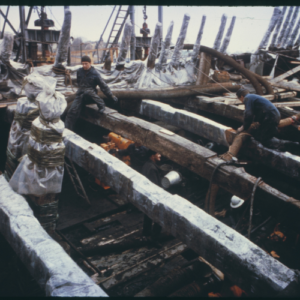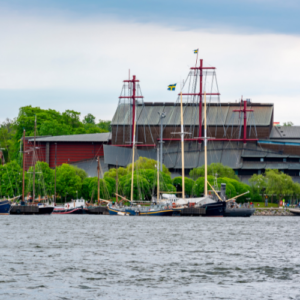The Build
The Lion of the North, Gustav II Adolf, is building Sweden into one of the most feared powers in Europe. In January 1625, the Swedish king signs a contract with the Dutch master shipwright Henrik Hybertsson and his business partner, Arendt de Groote. They are to build four new ships. One of them, Vasa, is to be the most powerful warship in the Baltic, if not the world. It is the beginning of one of the most spectacular fiascos in Swedish history.
The machine of war is launched
The king´s newest and most powerful ship, Vasa, is launched in the spring and hundreds of craftsmen work through the summer to finish the hull and rigging. When completed, a giant of a ship of its time is born.
Her cannon could fire 250 kilograms of ammunition in a single broadside, and when the heavy iron shot left the muzzles, they traveled near the speed of sound. For a brief few minutes, she was the most powerfully armed ship in the Baltic, if not the world.
Vasa carried 64 cannons when she set off on her maiden voyage in August 1628, but eight of the gunports were empty; the navy yard could build a ship faster than the royal gun foundry could cast its guns. The main armament was 48 24-pounders, powerful bronze cannon that fired round shot weighing ten kilograms each. The upper deck carried smaller cannons: eight 3-pounders (1.25 kg) and six, short, thin-walled guns for firing anti-personnel ammunition at short range.
The 24-pounder was a new type of gun developed in 1620 for the army as mobile siege artillery. It weighed only half of the traditional naval 24-pounder and was part of the king’s drive to standardize the weaponry of both the army and navy to make it easier to manufacture and supply ammunition.
The cannon on either side of the ship could fire a broadside of 250 kilograms, around four times as much as the typical Swedish warship of the 1620s, and twice as much as the largest ships in other northern European navies. Had she been able to carry sail, Vasa would have been a fast ship, and this combination of speed and firepower could have been devastating.

The catastrophe
The captain supervising the construction of Vasa, Söfring Hansson, calls Vice Admiral Klas Fleming down to the ship because he is worried. He has thirty men run back and forth across the deck and the ship rolls alarmingly. The Admiral has the demonstration stopped, afraid the ship will sink at the quay. Under pressure from the king to get the ship to sea, he orders Söfring to sail anyway. Months later, Vasa sets off on its first and last voyage.
What started with church services and a festive atmosphere ended in a watery grave. It was the 10th of August 1628, when Vasa, the most powerful warship in the Baltic, foundered in Stockholm harbor before the eyes of a large audience, scant minutes after setting sail for the first time.
It was mid-afternoon when at last it was time. After many delays, frustrations with the supply of guns, and a change of captain, the newly fitted out Vasa was anchored below the castle, with its cannon finally on board and the crew manning their stations. The quay was packed with people and the water teemed with small craft carrying people who wanted to watch the mighty war machine slip its moorings and sail from Stockholm.
The crew had been allowed to bring their families, as it was the ship’s maiden voyage. The guests, including women and children, would disembark at the fortress of Vaxholm before the ship continued to the summer fleet base on the island of Älvsnabben in Stockholm archipelago. There it would be the flagship of the reserve squadron, awaiting further orders as to whether to reinforce the blockade of Gdańsk in the stalemated, bloody war against Poland-Lithuania or to join the Swedish squadron protecting the German port of Stralsund. Only then would the ship’s complement of marines, two companies of soldiers totaling 300 men and officers, come aboard. But the soldiers were never to set foot on Vasa.
10 August 1628 was a Sunday, and many of Vasa’s crew had received communion earlier in the day. Hopes were high as people bid farewell or followed the ship from the quay, but some aboard the ship were worried.
Vasa cast off from the palace between four and five o’clock. Perhaps musicians struck up a suitably martial tune. Because the wind was from the south, the ship had to be warped with the help of anchors along the waterfront to the other end of the city island, to the place now called Slussen. Here, she could pick up the current that would take her down the harbor. As the ship found the current, the last warp was cast off, Vasa was freed from the land, four of the ten sails were set, and a salute was fired.
There was little wind under the bluffs of Södermalm, not even enough to pull the sheets of the sails taught, and Vasa drifted on the current, not answering her helm. A small gust filled the sails, and the ship heeled to port, but slowly, agonizingly recovered. As the ship passed the gap in the bluffs at Tegelviken, a much stronger gust pushed the ship so far over on its port side that water poured in through the open gunports on the lower gundeck. Vasa began to sink.
Pandemonium reigned on deck. The captain ordered the sheets cast-off to spill the wind from the sails and the gunports closed. Vice Admiral Erik Jönsson ran below to make sure the cannon had not broken loose. Many threw themselves into the water, while those below decks struggled to make their way up wildly tilting ladders. Within minutes, the ship was on the sea bed at a depth of 32 meters. The masts stuck up above the surface, and many grabbed hold of them. Others were picked up by the small craft that had followed Vasa’s shaky journey at close quarters. Some swam the 120 meters to the shore of Beckholmen.
All but 30 of the crew and guests survived when Vasa sank. Most of the dead were trapped inside the ship. We only know the names of a few people on board, mostly those who survived the catastrophe. The captain, Söfring Hansson, abandoned Vasa late, almost too late, as he was dragged under by the sinking ship and only barely reached the surface in his heavy, sodden clothes.
Erik Jönsson also survived, but his escape was even closer. Below decks checking the guns when the ship began to sink, the ladder on which was climbing collapsed and he was struck by a hatch cover. He was pulled from the water and lay near death for some time.
Among the dead was Captain Hans Jonsson. He had been named as Vasa’s original captain before being replaced by Söfring Hansson. He was still on board, as it was common to take a second experienced captain on the first cruise of a new ship.
There was mourning in Stockholm for those lost, and relief among those who survived. There was anger among those who had built the ship, but the overriding emotion was astonishment: how could such a thing have happened?
A fearful Royal Council writes to tell the king of the disaster. An inquest is launched. The ship´s officers claim innocence. The builders are adamant that they built the ship according to the design the king approved. The experts believe the ship had too little belly, and not enough hull to carry the heavy upper works. The blame falls on the designer, Henrik Hybertsson, for the poor proportions. Master Henrik, dead more than a year, cannot defend himself and does not need to be punished.

The Salvage
Some have called it Sweden’s Apollo Program, a dramatic and complex technical effort over several years to do something few thought possible: raise an intact 17th-century warship from the bottom of the sea. Even today, many still remember where they were when Vasa finally rose from the deep after 333 years in darkness.
Per Edvin Fälting and Sven Persson had confirmed on 4 September 1956 that the small plugs of wood in Anders Franzén’s corer came from a ship. Feeling their way in the dark, every step kicking up a swirling mass of silt, they had established that a large ship with two tiers of gunports, intact to the point that one mast was still standing, lay on the bottom of Stockholm harbor. The news was electric. The question was, what next?
Armed with the knowledge of the ship’s history and the divers’ reports, Franzén threw himself into building the coalition of institutions that could raise and restore the ship for the museum he envisioned. The task would require the technical expertise of many kinds, from diving and salvage to preservation. It needed historical and archaeological knowledge of the early 17th century. Most of all, it would require money, manpower, and heavy equipment.
Through his network of contacts, Franzén knew where to find the right people. He persuaded each, in turn, to join the project and commit the needed resources. The navy assigned Commodore Edward Clason, the commander of the navy’s diving assets, to run the project and Fälting as the dive boss, as well as all of its divers, in the form of their annual training courses. The Heritage Board detached a conservator, Bo Lundvall, who would spend his entire career with Vasa. The museum assigned Edward Hamilton, a retired naval officer, and historian, and agreed to curate the finds. Broströms, the biggest marine salvage company in Scandinavia, with years of experience in raising sunken ships, assigned one of their divisions, the Neptune Diving and Salvage Company, to engineer and carry out the lift, and agreed not to charge a penny for it.
Franzén was also interested in the royal court in Vasa. The king, Gustav VI Adolf, was an archaeologist by training and threw his support behind the ship built by his namesake. His son, Prince Bertil, one of the most popular members of the royal family, became the chairman of the foundation established to raise the ship, Wasanämnden (the Vasa Board).
Vasa quickly became a national celebrity and suggestions for how to raise the ship soon started pouring in. Creative ideas, such as filling the hull with ping-pong balls, or freezing it in a gigantic ice cube, were quickly discarded; the Neptune Company made it clear that they would only participate if they could use a reliable method for which they were already equipped. So between 1957 and 1959, navy divers dug six tunnels under Vasa and pulled massive steel cables through them to suspend the ship in a basket. At the surface, these cables were taken to two floating pontoons, named Oden and Frigg. By pumping the pontoons almost full of water, then tightening the cables and pumping the water back out, Vasa could be broken free of the mud and lifted and moved into shallower water.
As the divers dug with high-pressure waterjets and dredges, they encountered a fascinating array of finds that had fallen off the ship, from rigging hardware to gunport lids, and the first of more than seven hundred finely carved sculptures. They also found the mainmast lying next to the ship, and the ship’s longboat. When one of Vasa’s cannons was discovered, the raising on 5 September 1958 was covered live by Swedish Radio. The ship became a constant feature of the news, and Fälting, the tough, non-nonsense dive boss, became a national hero.
On 20 August 1959, all was ready for the initial lift. Would the pontoons have enough power to pull the ship free of the mud? Would the hull hold together under the strain? The pumps were started, and the pontoons began to rise. Vasa was free again after 331 years! As the ship was lifted it was moved into shallower water, set down, and the process repeated, Each lift gained a little less than a meter, and in 18 stages the ship was moved into the lee of Kastellholmen, where divers could work year-round at 17 meters depth to prepare the ship for the final lift.
For more than 18 months, a small team of commercial divers plugged holes where bolts had rusted away, fitted covers over the open gunports, and rebuilt the bow and stern to make them watertight. Steel rods were fastened across the hull to help hold it together. It was also important to make the ship lighter. The central part of the upper gundeck, which was covered with mud and debris, was cleared. More than a thousand objects were found: coins, personal belongings, gun carriages, tools, and the bones of five people who had been on board when the Vasa foundered.
On Monday, 24 April 1961, thousands of people crowded the shores around Kastellholmsviken, much as they had lined the shore almost 333 years earlier. Radio, television, and newspaper reporters filled special media boats at the center of the action, and Swedish Television broadcasted live to all of Europe.
The clock showed 09.03 when the tops of a few eroded frames peeked out of the water. Soon, the carved heads of four warriors emerged, followed by the outline of the whole ship at last. It really was a ship, come back from the dead, a sensation. Even today, many still remember where they were when Vasa rose from the deep.
Much remained to be done. Thousands of tons of mud and water had to be pumped out of the hull to refloat it, and the ship had to be moved onto a pontoon of its own, where it could be excavated and conserved. Archaeologists had to come on board to excavate the interior, and conservators had to begin the arduous process of treating the ship so it would not shrink and crack. Divers would spend five more years recovering thousands of loose pieces of the beakhead, sterncastle, and upper deck, which lay around the hole where the ship had been, together with the ship’s longboat and anchors. But April 1961 represent a milestone, a good start on the long road to the museum we have today

The Museum
By Friday 16 February 1962, the ship is ready to be displayed to the general public at the newly-constructed Wasa Shipyard, where visitors can see Vasa while a team of conservators, carpenters, and other technicians work to preserve the ship. The museum opens with a salute from two of Vasa’s cannons. Public interest is enormous and success is immediate – in 1962, 439,300 buy a ticket to see the ship and its unique finds.
Reconstructing and preserving a mighty warship from the 17th century is an enormous challenge. When waterlogged wood dries out, and the moisture in it evaporates, it shrinks and cracks. In order to prevent Vasa from being destroyed, conservation of the ship begins using polyethylene glycol, PEG, to replace the water. Loose objects are placed in large baths, while the hull of the ship is sprayed around the clock with the help of 500 nozzles and an elaborate pumping and filtering system. This treatment will continue until 1979.
Some things just take time. Even after being sprayed for 17 years, the ship has a long way to go. The wood has to dry slowly to avoid cracking, and over the next ten years, the humidity is gradually lowered. In fact, drying will go on for decades until the ship stabilizes completely.
1990 Vasa gets a new home, 384 proposals from all over the Nordic countries are received when an architectural competition to build the new Vasa Museum is launched in 1981. Swedish architects Hidemark Månsson Arkitektkontor AB wins against tough competition and, on 15 June 1990, the new museum is officially opened. The ship is the centerpiece of themed exhibits about all aspects of naval life in the early 17th century.
In the summer of 2000, the weather is terrible, with nearly constant rain. Tens of thousands of wet visitors raise the humidity in the museum, and it swings wildly each day as the overworked climate plant tries to catch up. Then alarm bells ring for the conservation staff: yellow and white spots appear on the ship and many of the artifacts. These suggest that the high humidity is combined with sulfur in the wood to produce destructive acids. Media reports trumpet that the ship is in danger of dissolving away before the visitors’ eyes. The immediate solution is an entirely new, state-of-the-art climate plant, online in 2004, and the launch of an international research project to understand what is happening in the wood and correct it.
Tourists make the pilgrimage when Vasa celebrates the 50th anniversary of its recovery from the depths. The Vasa Museum sets a new record with well over 1.2 million visitors. After half a century of conservation and restoration work, the success of Vasa is easy to understand: it is a unique and intact ship from a forgotten time. Over 98% of the original structure survives, including masts and sails, so it does not look like a wreck, but a ship awaiting the start of the next voyage, just as Vasa looked in the winter of 1628.
As the only Swedish entry, the Vasa Museum, in ninth place makes it onto the top 10 list of the world´s best museums according to TripAdvisor, the world´s largest travel site.
If you would visit the museum today it is Open daily from 10-17, and Wednesdays open until 20.
Admission
Adults (including senior citizens):
SEK 190
Young visitors: 0-18 years: Free of charge
Normally a visitor stays at the Vasa Museum for 1½ – 2 hours.
You are welcome to take as many photos/videos as you wish inside the museum. Feel free to use flash and tripods, for personal use, if you are going to use the photos for commercial purposes please contact the information office of the museum.
The Vasa museum offers free audio guides in 19 different languages.
Companions to visitors with disabilities have free admission.
Assistance dogs are welcome. No other pets.
Lifts are available on all floors, the museum has a total of 7 floors.




